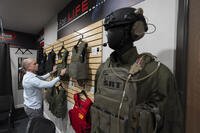Growing military cooperation between the U.S. and India will involve increased military sales, joint exercises and co-production agreements, Indian Defense Minister Manohar Parrikar said Monday.
And while Indian news outlets said Parrikar would explore the possibility of India buying armed unmanned aerial vehicles during his three-day visit, there was no mention of armed drones at the news conference with Defense Secretary Ashton Carter or in a joint cooperation statement issued by both sides.
The Indian military is rumored to be interested in acquiring the Predator C Avenger jet-powered drone made by General Atomics Aeronautical Systems Inc. of San Diego.
In addition, the strengthening of defense ties between the two countries won't include any basing of U.S. ships and troops in India, the defense minister said.
"There is no provision for any base," Parrikar said at a Pentagon news conference with Carter. He added, "The partnership between our armed forces has grown from strength to strength."
Parrikar noted that India recently participated in the Rim of the Pacific naval exercises off Hawaii and would host U.S. Army troops in India next month for Yudh Abhyas (Training for War) exercises.
"Both of us are satisfied at the progress," he said, referring to himself and Carter. "Defense cooperation between the U.S. and India has never been stronger" and would form "one of the defining partnerships of 21st century."
Parrikar will also visit a Boeing facility outside Philadelphia that is making CH-47F Chinook heavy-lift helicopters to become part of the Indian Air Force in 2019 to provide heavy-lift capabilities at high altitudes.
Last September, the Indian government placed a $3.1 billion order for 22 AH-64E Apache Longbow attack helicopters and 15 Chinooks for its air force. India is in the process of phasing out three Soviet-era Mi-26 helicopters for high-altitude missions.
Earlier, Parrikar and Carter signed a long-awaited Bilateral Logistics Exchange Memorandum of Agreement to "facilitate additional opportunities for practical engagement and exchange" to build on cooperative agreements already underway.
In July, India and the U.S. agreed to set up new technology initiative working groups on naval systems; air systems; Intelligence, Surveillance and Reconnaissance; and "other systems."
The U.S. earlier this year agreed to share with India jet engine technology. And on a visit to New Delhi last April, Carter said that the U.S. also was willing to share technology with India on the new launching and landing systems installed on the latest U.S. aircraft carrier, the Gerald R. Ford.
"We are working with the Indian Navy on technology for their next generation of aircraft carrier," Carter said at the time.
The Ford, which has experienced cost overruns and problems with the launching and landing systems that have delayed commissioning by more than two years, features an Advanced Arresting Gear system for carrier landings and an Electromagnetic Aircraft Launch System that will replace the steam catapults used on older U.S. carriers.
At the Pentagon, Parrikar met with the leadership of the Defense Innovation Unit Experimental, which is seeking to forge closer ties with the high-tech community, and visited U.S. Cyber Command.
He also will visit the Defense Advanced Research Projects Agency and Joint Base Langley-Eustis, Virginia, for a tour of the Air Combat Command and the 480th Intelligence, Surveillance and Reconnaissance Wing.









